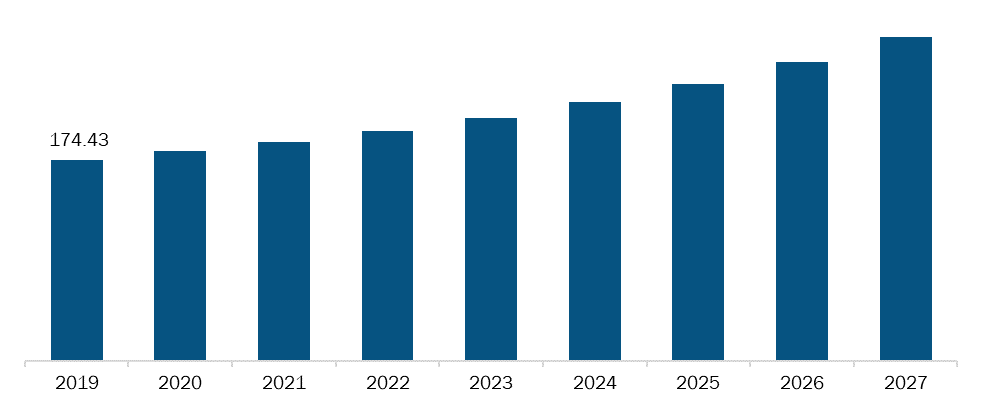The North America drug modelling software market is expected to reach US$ 4,588.87 million by 2027 from US$ 2,468.17 million in 2019; it is estimated to grow at a CAGR of 8.4% from 2020 to 2027.
Increasing adoption of in-silico modelling tools in drug discovery, and increasing economic burden of drug discovery in the region are the key factors driving the growth of drug modelling software. However, lack of data standardization is the major factor hindering the market growth in North America.
Drug modelling has become an essential tool in the drug design process. Software based drug discovery and development methods are playing key role in the development of novel drugs. Software based methods such as molecular modelling, structure-based drug design, structure-based virtual screening, ligand interaction and molecular dynamics are considered to be powerful tool for investigation of pharmacokinetic and pharmacodynamic properties of drugs. These methods are fast, accurate, and provide valuable insights of experimental findings and mechanisms of action. In addition, appropriate implementation of these techniques may help in reducing cost of drug designing and development.
The discovery and development of new drugs with potential therapeutic applications is a complex, expensive, and time-consuming venture. Considering this challenge, many novel technologies have been developed to increase the efficiency of the drug discovery process. Computational methodologies have become a crucial part of several drug discovery programs. From hit identification to lead optimization, techniques such as ligand or structure-based virtual screening are widely being used by many pharmaceutical companies. With the help of modelling, existing data can be leveraged to gain insights on product safety and effectiveness. Owing to computational methods efficiency, the FDA have included modelling to support efficient drug development. Nowadays, In-Silico design (computer-aided) is being utilized to expedite and facilitate hit identification, optimize the absorption, distribution, metabolism, and toxicity profile to avoid safety issues. Commonly used in-silico approaches include ligand-based drug design, structure-based drug design, and quantitative structure-activity.
Drugs are essential to stopping more suffering at the hands of Covid-19; at the time of writing, more than 206,000 people have tragically died from the disease. However, in the U.S., to give the technology a push, the ImmunityBio and Microsoft collaborated to support for the research. Supporting Covid-19 drug and vaccine development is the aim of ImmunityBio’s collaboration with Microsoft to leverage the latter’s Azure platform to create a 3D model of SARS-CoV-2’s spike protein. Additionally, Research projects and innovations related to COVID-19 have ramped up quickly across the University of Michigan, spurred by doctors, public health experts, scientists, economists and engineers, and encouraged by research leaders.
With the emerging outbreak of the COVID-19 pandemic, the drug modelling software market is likely to be positively impacted.
Mexico Drug Modelling Software Market, Revenue and Forecast to 2027 (US$ Mn)

- This FREE sample will include data analysis, ranging from market trends to estimates and forecasts.
NORTH AMERICA DRUG MODELLING SOFTWARE MARKET SEGMENTATION
By Product Type
- Database
- Software
- Others
By Application
- Drug Discovery and Development
- Computational Physiological Medicine
- Disease Modeling
- Medical Imaging
- Predictive Analysis of Drug Targets
- Simulation Software
- Cellular Simulation
- Others
By Country
- US
- Canada
- Mexico
Company Profiles
- Crown Bioscience Inc (JSR life science)
- Chemical Computing Group ULC
- Nimbus Therapeutics
- Schrödinger, Inc
- Leadscope, Inc (Instem)
North America Drug Modelling Software Report Scope
| Report Attribute | Details |
|---|---|
| Market size in 2019 | US$ 2,468.17 Million |
| Market Size by 2027 | US$ 4,588.87 Million |
| CAGR (2020 - 2027) | 8.4% |
| Historical Data | 2017-2018 |
| Forecast period | 2020-2027 |
| Segments Covered |
By roduct Type
|
| Regions and Countries Covered |
North America
|
| Market leaders and key company profiles |
|
- Historical Analysis (2 Years), Base Year, Forecast (7 Years) with CAGR
- PEST and SWOT Analysis
- Market Size Value / Volume - Regional, Country
- Industry and Competitive Landscape
- Excel Dataset
Recent Reports
Testimonials
Reason to Buy
- Informed Decision-Making
- Understanding Market Dynamics
- Competitive Analysis
- Identifying Emerging Markets
- Customer Insights
- Market Forecasts
- Risk Mitigation
- Boosting Operational Efficiency
- Strategic Planning
- Investment Justification
- Tracking Industry Innovations
- Aligning with Regulatory Trends





















 Get Free Sample For
Get Free Sample For